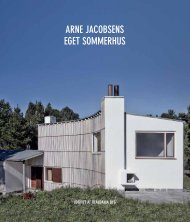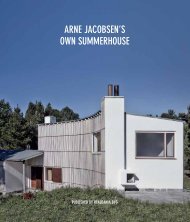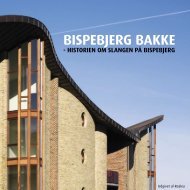the Vision of BispeBjerg Bakke - Realdania Byg
the Vision of BispeBjerg Bakke - Realdania Byg
the Vision of BispeBjerg Bakke - Realdania Byg
- No tags were found...
You also want an ePaper? Increase the reach of your titles
YUMPU automatically turns print PDFs into web optimized ePapers that Google loves.
challenge: people at <strong>the</strong> Chinese factory<br />
could not understand that we wanted to<br />
use this special red colour, which <strong>the</strong>y<br />
would normally associate with art objects<br />
ra<strong>the</strong>r than buildings. So Bjørn explained<br />
to <strong>the</strong>m that our building was also a work<br />
<strong>of</strong> art”, explains Torben Sørensen. Bjørn<br />
Nørgaard had previously had a piece <strong>of</strong><br />
sculpture made at this Chinese factory, so<br />
he knew that <strong>the</strong>y were equal to <strong>the</strong> task.<br />
He explains: “I knew that <strong>the</strong>y could make<br />
<strong>the</strong>se tiles from drawings. We also have<br />
superb producers <strong>of</strong> ceramics in Denmark,<br />
but <strong>the</strong>y would not be able to reorganise<br />
<strong>the</strong>mselves to produce <strong>the</strong>se tiles, whereas<br />
<strong>the</strong> Chinese had <strong>the</strong> whole production<br />
apparatus. There was some trouble<br />
getting <strong>the</strong>m to make <strong>the</strong> tiles exactly as<br />
we wanted <strong>the</strong>m, but we succeeded, not<br />
least due to Torben Sørensen’s skills as a<br />
negotiator. These tiles have introduced<br />
one more layer into <strong>the</strong> building project.<br />
One <strong>of</strong> <strong>the</strong> major qualities <strong>of</strong> Bispebjerg<br />
<strong>Bakke</strong> is precisely that we have so many<br />
layers. We have hi-tech, advanced digital<br />
technology, industrial products like concrete<br />
and craftsmanship in <strong>the</strong> form <strong>of</strong><br />
brickwork and copper ro<strong>of</strong>ing. And <strong>the</strong>n<br />
we’ve got ceramic tiles with a glazing<br />
more than a thousand years old, which<br />
at <strong>the</strong> same time represents <strong>the</strong> globalisation<br />
layer, as <strong>the</strong> tiles are produced in<br />
China”.<br />
Blessing in Disguise<br />
The vision <strong>of</strong> a full-brick building constructed<br />
by craftsmen carrying on <strong>the</strong>ir<br />
traditions had to make way for concrete<br />
sections and a construction process in<br />
which <strong>the</strong> building contractor exerted a<br />
certain influence. But even so, ambitions<br />
related to <strong>the</strong> use <strong>of</strong> craftsmanship came<br />
to have a decisive influence, so much so<br />
that changes in approach have in fact improved<br />
<strong>the</strong> snake-shaped building. Today,<br />
when those who have created Bispebjerg<br />
<strong>Bakke</strong> look back on <strong>the</strong> project, <strong>the</strong>y are<br />
convinced that <strong>the</strong> building process was<br />
enhanced and <strong>the</strong> building itself became<br />
more innovative because <strong>the</strong> idea <strong>of</strong> letting<br />
craft methods completely control <strong>the</strong><br />
building process was abandoned. As Jesper<br />
Holm puts it: “This is very interesting,<br />
because in fact <strong>the</strong> building has gained<br />
both architecturally and in terms <strong>of</strong> indoor<br />
climate by moving away from <strong>the</strong> sublime<br />
vision <strong>of</strong> craftsmanship to a more industrial<br />
approach, in <strong>the</strong> sense that it has been<br />
improved in a number <strong>of</strong> areas, <strong>the</strong> ro<strong>of</strong>,<br />
for example. The original idea was to construct<br />
<strong>the</strong> ro<strong>of</strong> by getting <strong>the</strong> carpenters to<br />
shape each individual beam or rafter and<br />
put <strong>the</strong>m in place one by one. This is a<br />
very time-consuming process, and as <strong>the</strong><br />
whole thing is exposed to <strong>the</strong> wea<strong>the</strong>r,<br />
<strong>the</strong>re is a real danger that <strong>the</strong> ro<strong>of</strong> would<br />
have been attacked by mould at some later<br />
date. Not only that, it would have been<br />
a very heavy ro<strong>of</strong> in architectural terms.<br />
Using <strong>the</strong> industrial approach, <strong>the</strong> ro<strong>of</strong> was<br />
laid using complete ro<strong>of</strong> sections which<br />
were made indoors without <strong>the</strong> fear <strong>of</strong><br />
damp. So now we have this light ro<strong>of</strong> construction<br />
and <strong>the</strong> whole process has been<br />
a development project, which our drawing<br />
<strong>of</strong>fice has benefited greatly from”. Bispebjerg<br />
<strong>Bakke</strong> has become a model for how<br />
one can combine <strong>the</strong> noble traditions <strong>of</strong><br />
craftsmanship and industrial construction<br />
methods. As Klaus Bonde Larsen points<br />
out, craftsmanship has in no way lost out<br />
in this process: “The building was controlled<br />
by <strong>the</strong> contractors, but even so <strong>the</strong> old<br />
techniques and quality materials <strong>of</strong> <strong>the</strong><br />
craft tradition have been drawn in. The<br />
shape and appearance <strong>of</strong> <strong>the</strong> building are<br />
much as <strong>the</strong>y were meant to be from <strong>the</strong><br />
start. None <strong>of</strong> us would have believed that<br />
<strong>the</strong> building <strong>of</strong> Bispebjerg <strong>Bakke</strong> would involve<br />
innovation, but this has turned out<br />
to be <strong>the</strong> case. The concrete factories have<br />
never before made <strong>the</strong> curving units <strong>the</strong>y<br />
have produced here. So in this way <strong>the</strong>re<br />
have been a whole lot <strong>of</strong> new products<br />
which can set <strong>the</strong> trend in <strong>the</strong> future. The<br />
building could not live up to <strong>the</strong> vision that<br />
<strong>the</strong> craftsmen could run <strong>the</strong> whole process<br />
with no help from <strong>the</strong> building contractors,<br />
but in my view it lives up to <strong>the</strong><br />
58 59
















